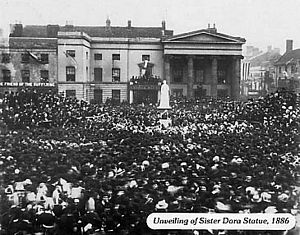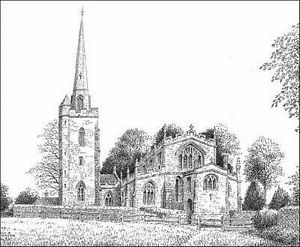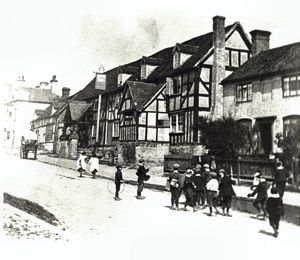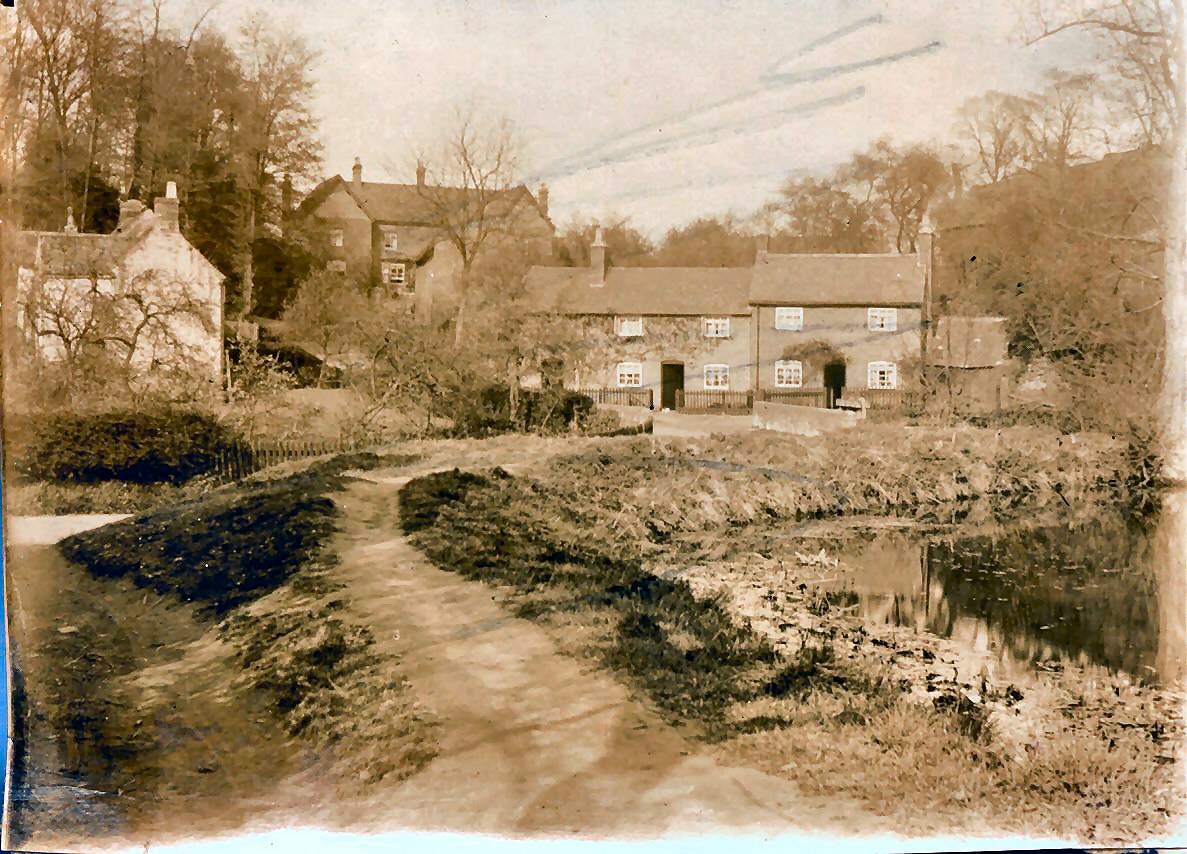|
Descriptions of places referred to in the history of the family |
1.3. Geographical locations. In common with most people in past centuries, the Hildick, Smith and |Page families have strayed little from one relatively small geographical area. From the mid 19th C to the early 20th C, the families have fragmented and moved away to South Africa, the USA, Canada, Rhodesia, Australia and many parts of the UK. However, there still appears to be Smiths and Hildicks living in and around Walsall and many of Elsie Pages family remain in Chaddesley Corbett. . Walsall, in what is now The West Midlands and was formerly Staffordshire, seems to have provided a home for all the generations of both families until the advent of rail and other forms of transport became available in the mid to late 19th C Walsall lies to the North of Birmingham in the Midlands. The following is taken from http://thisiswalsallwww..co.uk The earliest reference to Walsall was thought to be in a will dated c.1002-4 which refers to a place called 'Walesho', but this is debatable and requires further scrutiny. The place name of Walsall is now generally believed to derive from the Old English personal name 'Walh', thought to be from the Saxon term for a Briton or Welshman, and 'H(e)alh' meaning 'a sheltered place'. Walsall was omitted from the Domesday Book (1086) - perhaps due to a clerical error, though this is unknown. The medieval town grew up in a cross shape, with the highest point, Church Hill, at its head, standing 511 feet above sea level. The other points of the cross reached down to Town End, and along Peal Street and Rushall Street. A church has stood on the hill since at least 1200 and the St. Matthew's Church, originally dedicated to All Saints, still contains a 13th century inner crypt. [Many generations of both the Hildick and the Smith families have used this church, perhaps many met in the course of their worship.] A market has been held in High Street since c.1220 and is still a popular attraction. Originally Walsall thrived as an important market town and had a primarily agricultural economy for many centuries. However, the Borough had good supplies of coal, ironstone and limestone, enabling metalwork industries to prosper, and light metalwork has been the traditional industry of Walsall since the 16th century or earlier. Bits, stirrups, buckles and spurs have been made locally for centuries, and from this lorinery trade developed the manufacture of saddlery and leather goods for which Walsall is famous. The Industrial Revolution encouraged these small industries to grow on a huge scale. Transport systems developed to carry the coal and iron to customers nationwide; many foundries, ironworks and mines opened which exploited the development of local canal and railway networks to transport their heavy goods. The extraction of limestone, used in both industry and agriculture in large quantities, has left its legacy in the subsidence problems which have appeared in Walsall over the years. More positively, some quarries were flooded to create the Arboretum park lakes. The Arboretum was opened in 1874 and entrance charges were abolished in 1885 when it became a free public park. The population of Walsall increased dramatically during the 19th century, doubling and then tripling, as people came to work in the town's prospering industries. Much of the housing, built in haste to accommodate the influx of workers, was of a poor standard and has since been demolished. Unfortunately, redevelopment during the last 150 years has resulted in most of Walsall's historic buildings being lost - many fine buildings along with the slums. Famous inhabitants of Walsall include Jerome K. Jerome, the author of 'Three Men in a Boat' who was born in Belsize House, Bradford Street in 1859. Sister Dora was born Dorothy Wyndlow Pattison in Yorkshire in 1832. Her pioneering nursing work, as she developed Walsall Cottage Hospital, earned her national respect. She died in 1878 and eight years later a statue to her memory was unveiled on The Bridge. This was the first statue of a woman not of royal birth ever to be erected in Great Britain. ( Note: John Hildick b 1825 was instrumental in setting up this hospital and knew Sister Dora well, see later entries for details.)
"Rushall is a village and parish on the Lichfield road, one mile NE of Walsall, containing about 1800 acres of land, abounding in excellent coal and limestone, the latter much celebrated for its superior quality, taking a polish almost equal to marble, and raised from mines nearly 80 yards below the surface. The recent large increase in population has occurred chiefly in Ryecroft, on the north side of Walsall, where the inhabitants are chiefly miners. The most attractive objects in Rushall are the ruins of the ancient Manor house, which, during the wars of the Roses, and of those between Charles I and Parliament, was strongly fortified and defended by a numerous garrison. During the civil wars, a Mr. Pitt, of Wolverhampton, attempted to bribe Captain Tuthill to betray the garrison of Rushall, but his treachery was discovered, and he suffered death for it in 1640. Rushall Hall, a modern house, has been built near the ruins and is occupied by Mr. Cowley. The manor anciently belonged to the family of Boweles, who passed it to that of Grobbere, and afterwards to the Harpurs, one of whom, John Harpur, Esq, endowed the vicarage, and rebuilt the church about the year 1444. Early in the 17th century, the manor became the property of the Leighs, from whom it passed to the late Rev Edward Mellish, whose executors, W & G Mellish, B Gurdon and W Tritton, Esqrs, are now the principal proprietors and lords of the manor. Dawend and the Butts are two hamlets within half a mile of Walsall. The limestone mines of this parish are situated at the former, where there is a branch of the Wyrley & Essington Canal. Near to them and Walsall is the populous mining district of Ryecroft, where fine sand is got for the glass manufacturers, and an excellent loam for the foundries." [From History, Gazetteer and Directory of Staffordshire, William White, Sheffield, 1851] Lapworth in Warwickshire became the family home of the Hildicks some time in the early 1800s, although land was owned by members of the family from 1792. From : http://freespace.virgin.net/m.polgreen/ comes: Lapworth is a village in Warwickshire situated between Warwick and Birmingham. It has a population of about 2000. Although there is some local employment in farming and service industries it is chiefly a commuter village for the larger surrounding towns of Coventry, Solihull and Birmingham. The village lies on the junction of two canals, the Stratford Canal, and the Grand Union Canal. Lapworth is in "green belt" and the pleasure of living here is to be separate from the suburban sprawl, and so to be able to enjoy country walks from the doorstep but to be within 45 minutes or an hour's commute of work. The millenium sign can be seen on the roadside as one enters the village on the Old Warwick Road from the direction of Hockley Heath. Although not a twee, picturesque village, of the type normally associated with Warwickshire the village does boast some fine old houses, including two National Trust properties, Packwood House and Baddesley Clinton. St Marys Church, Lapworth The parish church of St Mary's in the West of the parish and the Lees Memorial Chapel on Station Lane provide for the spiritual needs of the village. (Information from Brian Hildick, who has visited Lapworth, indicates that the “ancestral” home of the Hildicks was, at one time, a moated manor house and how the family came to Lapworth is described later.)
Lapworth Parish Church c1920 Chaddesley Corbett in Worcestershire has been the family home of the Pages and the Oldnalls since the 1700’s and many of the remaining family still live there. Chaddesley Corbett c 1890 A brief 'thumbnail' history of Chaddesley comes via Http://www.chaddesley-corbett.co.uk
Chaddesley Corbett ( The Talbot Inn) c 1900 A flint tool once used to cut and shape arrows was found near the village of Chaddesley Corbett. Archaeologists have dated this tool and it is thought to originate from between 2000 to 5000BC. Further proof of early settlement can be found at a prehistoric burial mound at nearby Barrow Hill. There was certainly some form of Roman settlement here as pottery and coins have been found over the years. The earliest documentary evidence of today's village is in a Saxon charter dated 816AD in which King Coenwulf of Mercia granted land and privileges to Bishop Denibert of the Priory of Worcester. The name of the village in this document is Ceadesleaghe and, again, is of Saxon origin and means 'The clearance belonging to Ceadda.' This latter word is thought to be a corruption of the Celtic word 'cader' or hill-fort. Chaddesley had become quite an important settlement by the time of Domesday and the population numbered 300-400. At the time of the Domesday survey, the manor of Chaddesley was held by a Saxon lady called Eddeve. This was unusual for, under William the Conqueror, she was allowed to retain the land. However, after her death the manor passed to the Crown and later, as a result of a marriage, was gifted to the Corbett family in the 12th century. The family's name was added to the settlement's title during the 200-year period in which they resided here. It is unclear to what extent the Corbett's were responsible for the rebuilding of the church during the 12th century but they were certainly responsible for the highly-praised 14th century chancel. [Andrew Page from Chaddesley reports that : One point I heard recently from a guy who I am working with on a project and who has been working on a film script of the relationship between William the Conqueror and Harold (of arrow in the eye fame). William and Harold at one time were 'friends' or as much friends as the Royal Mafioso of those days could be. Harold's wife was called Ealdgyth (as was his mistress which must have been useful if he forgot who he was in bed with). Ealdgyth was the daughter of Aelfgar, son of Earl Leofric of Mercia and his wife Godiva (of Coventry). My associate says that after Harold's death Ealdgyth changed her name to the more Norman Edeeve and was granted the manor of Chaddelsey for her lifetime. However Ealdgyth was a fairly common name at the time and was the name of the wife of Edward the Confessor who had promised the crown to William before Harold seized it. So if this Ealdgyth was the Lady Edeeve it would probably be a bit more logical. But whatever it shows the importance of the manor of Chaddesley.] Chaddesley passed into the estate of the Beauchamp family of Warwick in the mid-14th century and there is some evidence to suggest they attempted to elevate the village into a market town. Ownership of Chaddesley changed again in the early 15th century when the Earl of Warwick gave the village and part of the manor to St.Mary's Collegiate Church. A map from their stewardship was produced by James Fish in 1697 and many of the house's boundaries remain the same today which demonstrates great continuity. In fact, Warwick's St.Mary's Church still owns some houses in Chaddesley including The Swan Inn. The Pakington family bought the estate of Chaddesley in 1529 and they later moved into the moated manor house of Harvington Hall - just up the road from Chaddesley ( a visit to this old house is highly recommended). It has had quite a turbulent history. Elizabeth Holt, daughter of Sir Thomas Holt, took refuge here when their family home at Aston Hall was occupied by the Roundheads. Indeed, she died here and her memorial can be found at the church in the St.Nicholas Chapel. Following the restoration, Lady Mary Yate (nee Pakington) fell foul of the authorities for remaining true to her Catholic faith. She gave shelter to many Catholic priests and, in particular, to Father Wall. He was eventually caught at nearby Rushock Court and became the last Catholic martyr in England. Following Lady Mary's death in 1696, the estate passed by marriage by the Throckmorton family of Coughton Court near Alcester. During the 19th century they stripped the house of furniture, panelling and even the staircase which are all to be found at Coughton. However, following the restoration of the building, the house is one of the best glimpses into Elizabethan times that there is. The house still has many of the original wall paintings. The priest holes are ingenious and the work of Nicholas (alias Little John) Owen, who in 1606, was arrested at Hindlip House near Worcester and tortured to death in the Tower of London. Hillpool c 1900 Agriculture formed the basis of Chaddesley's economy and the farmers here were quite innovative. Part of an early irrigation scheme can still be found nearby. The expertise was collected by Chaddesley-born, John Broad, who published 'The Worcestershire Farmer or Young Farmers Guide' in 1778. The industrial revolution offered more diverse employment opportunities - the saw mills at nearby Cakebole are thought to be the first steam-powered mills in the county and a carpet factory emerged at Hill Pool which was also in the parish. (Note: The Page family desendants still live at Hill Pool House and the family owned and rented the mill to the Brinton family who became world leaders in carpet making.)
Hill Pool c 1900 with Hill Pool House at the rear The main street (of Chaddesley Corbett) is a treasure of old buildings the oldest of which date from the 15th century. Here you will find a diverse collection of architectural styles in a street Nikolaus Pevsner called 'one of the most attractive in the county.' The name of Tudor House may be slightly amiss but was once a substantial timber house. The rear of the building is much older than the frontage which dates from the mid-18th century. The building, with ogee headings on the gables and Venetian Gothic windows, was probably red brick at some time but stucco has been added since. The Golden Lion at Bromsgrove was of a very similar design. The house was once owned by James Rose who was the architect of the tower and spire of St.Cassians. However, the house has traditionally been the home of the village doctors. It is not clear whether Dr.Thomas Attwood lived here but he certainly once practised in the village. He achieved some notoriety as an occultist and is believed to have treated Dr.Samuel Johnson as a child. On the corner of Fisher's Lane is the old Malt House. Records of this timber-framed building can be traced back to the 16th century. However, it was burned down in the 18th century and had to be rebuilt by Sir Robert Throckmorton. The present shop window dates from around the 1960's but the building has seen many uses over the centuries. For many years it was a malthouse but some of the older villagers have fond memories of it being a cycle shop up until the Second World War. The Old Malthouse has even been used as a youth hostel. The adjacent Georgian house next door was probably built as a result of the fire here but it marked the introduction of classical architecture to this part of the village. You'll notice that the end walls project above the roof line which was a fashion attributed to London building regulations of that period.A little further along the road are Batch Cottages. Nikolaus Pevsner described these as 'the best timber-framed cottages in the street.' The name Batch relates to a stream or valley. It is thought that part of the cottages date from the 16th century. In the early years of the twentieth century they formed seven individual cottages but, although the frontages remain the same, they have now been converted into four houses. Just down the road is the old workhouse of the village. Harkaway House dates from 1795 but was largely rebuilt in the 1960's. It was used as a workhouse until 1838 when it's role was taken by the Union workhouse in Blakebrook, Kidderminster. Much of the detail above comes not only from the web site but also from a first edition book kindly supplied by my sister Jackie Morris. It is called “ Chaddesley Corbett” by “The Stroller” which is taken from a column written firstly in The Worcester Herald and continued in a series of articles in The Berrows Worcester Journal. It was published in 1932 and is signed by the author. |



